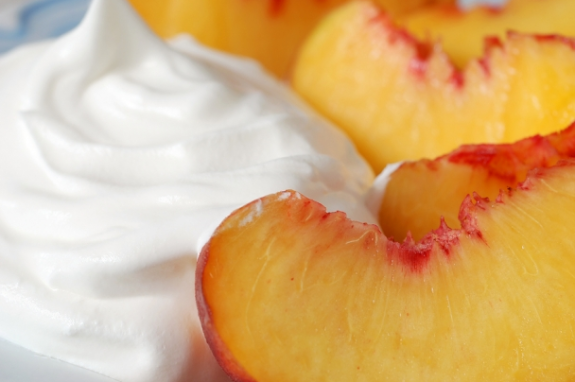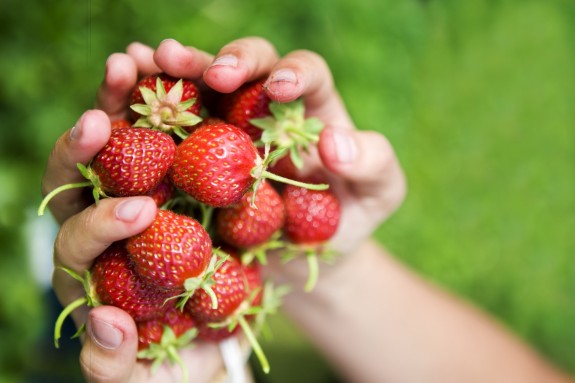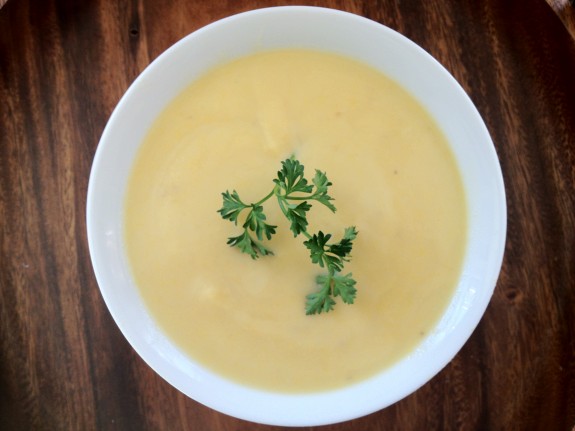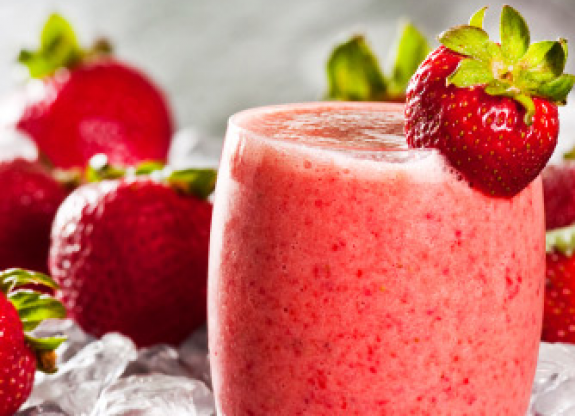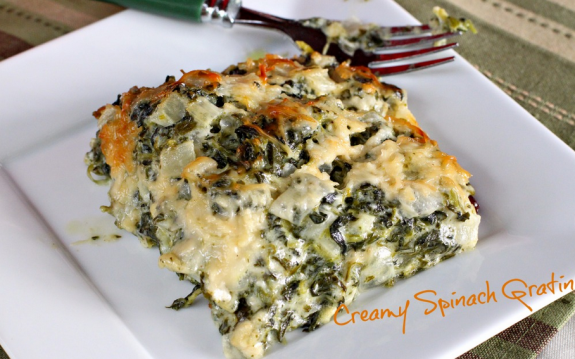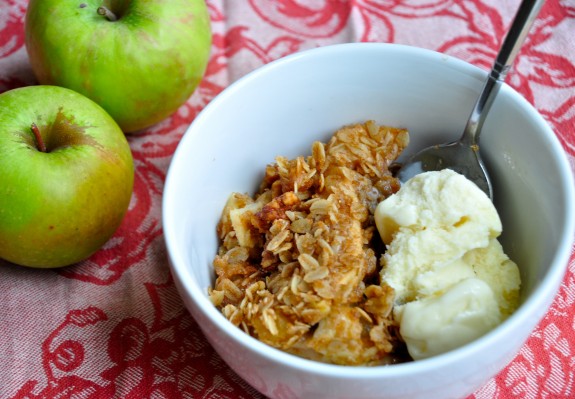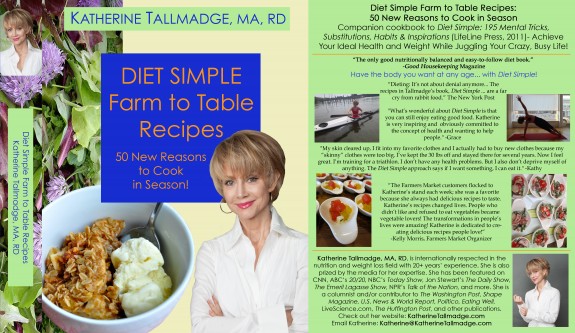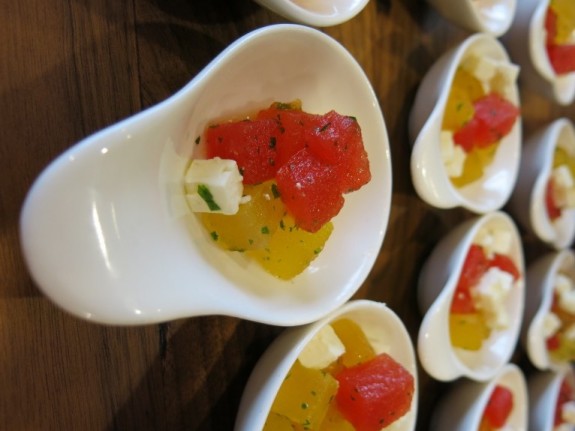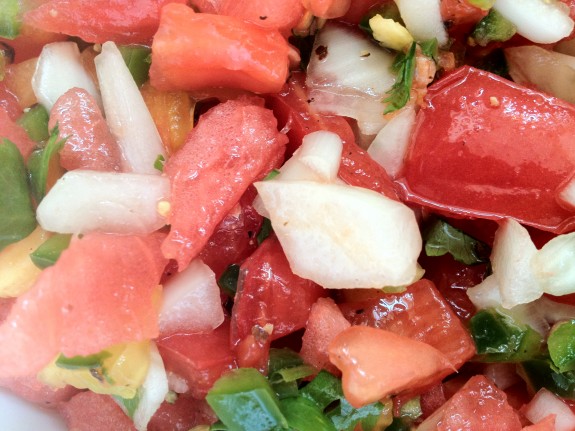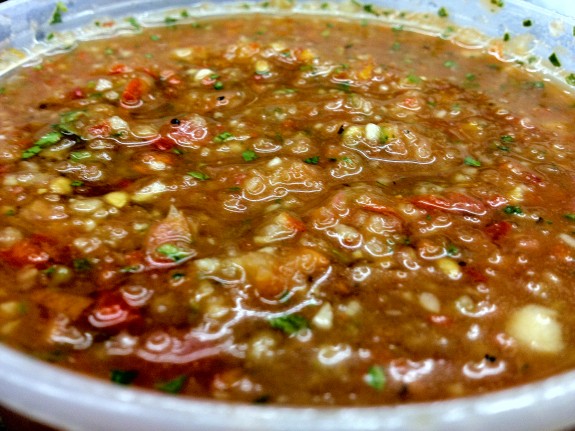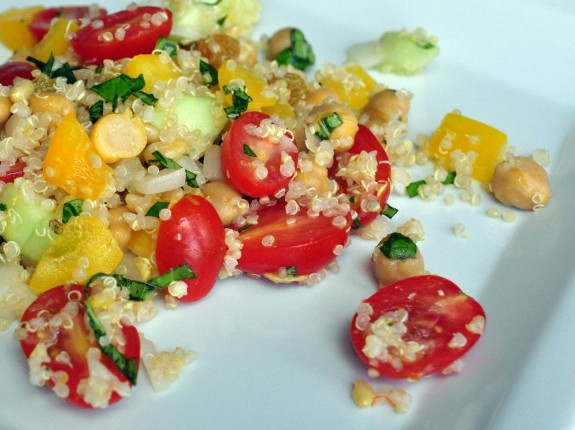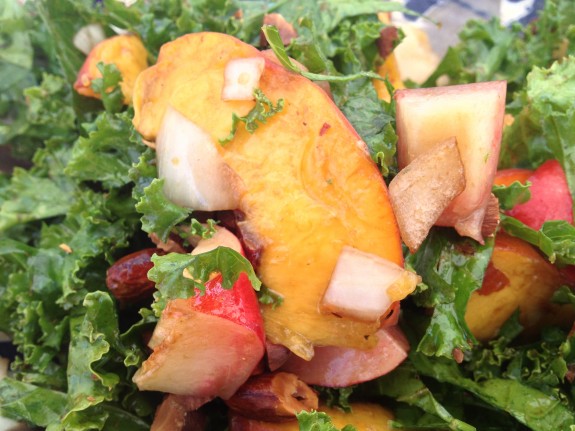A Creamy Peach & Ginger Surprise
Fresh, juicy peaches are in season and I have a new peach recipe you’ll love. Surprise: It’s made with Greek Yogurt (though it tastes like cream). Try it and your taste buds will zing! This amazing recipe was developed by the CHOBANI Company’s French-trained chefs, and I got a chance to watch a demonstration with a tasting. This is a lovely dessert containing all the health benefits of yogurt and peaches! Your family and guests will be delighted!
CHOBANI
Peach + Ginger
Yields four, 4 oz servings
INGREDIENTS
2 cups Chobani Non-Fat Plain Greek Yogurt
2 tsp. candied ginger, small dice 4 tbsp. toasted almonds, sliced
2 tsp. fresh thyme, picked
2 tbsp. honey
1 cup Peach and Ginger Compote
PEACH AND GINGER COMPOTE INGREDIENTS
4 yellow peaches, peeled, cored, small dice
1 tbsp. fresh ginger, minced
1 teaspoon lemon juice
1/2 cup sugar
METHOD
- Cook peaches, ginger, lemon juice, and sugar for 20 minutes or until tender. Let cool completely.
- Scoop 1/2 cup of yogurt into each of 4 bowls. Top each bowl of yogurt with 1/4 cup peach
and ginger compote, 1/2 tsp candied ginger, 1 tbsp toasted almonds and drizzle with 1/2 tbsp of honey. Garnish with thyme.110 calories per serving, 0 Fat, 5 mg cholesterol, 35 mg sodium, 17 g carbohydrate, 1 g fiber, 8 grams protein
Prenatal Fruit Intake Boosts Cognition in Infants + Springtime Strawberry Salad
Some of the most interesting nutrition studies I’ve read have to do with the prenatal diet and subsequent effects in children. The subject is vast and the outcomes amazing. Did you know that when pregnant moms drink high amounts of carrot juice during pregnancy, their toddlers are more likely to choose carrots over other vegetables? Or, that the more varied a pregnant mom’s diet, the more her child will choose and enjoy a wider variety of foods? All proven by science!
So it’s no surprise that a new study published in The Lancet found that prenatal fruit consumption is correlated with superior cognition in the mothers’ one-year-old infants – though there was no effect if fruit was only fed to the child during the year after birth. So, what may explain this finding?
Evolution may explain, in part, this advantage of fruit-eating. During the neolithic (stone age) period about 12,000 years ago and for thousands of years thereafter, we subsisted mainly on fruits and vegetables; which comprised about 65% of our calories, according to S. Boyd Eaton, from the department of Anthropology at Emory University in an interview and in his essay, “Evolution, Diet and Health.” That may mean that brain development is still dependent on the same high level of vitamins, minerals, antioxidants, and other positive nutrients that kind of diet would provide. And this could help explain why, even today, a high fruit diet is correlated with so many positive health benefits: reduced incidence of diabetes, heart disease, cancer, arthritis, eye disease, and other conditions. Keep in mind, too, that the health-giving Mediterranean Diet had 12 to 13 servings of fruits and vegetables daily, and it’s known as one of the healthiest diets on the planet.
Fruit is so easy to eat every day, and the local fruit season is just beginning to get exciting. I was most fortunate to receive one of the most delicious dishes I’ve ever eaten this weekend when my friend and neighbor, Mike Gardner, brought me his salad:
Kale! Kale! Everywhere!
Kale and Spinach Gratin with Garlic, Rosemary, and Thyme
(excerpted from Diet Simple Farm to Table Recipes)
Serves 6
1 pound Kale, cleaned and stems removed
2 pounds Spinach, cleaned and stems removed
1 Tablespoon Olive or Canola Oil
1 Large Garlic Clove, minced
2 teaspoons fresh Rosemary, chopped (or 1 tsp dry)
1 teaspoon fresh Thyme leaves, chopped (or ½ tsp dry)
1 recipe Olive Oil Bechamel Sauce (see recipe)
Salt and Freshly Ground Pepper to taste
¼ Cup Parmesan or Gruyere Cheese, freshly grated
Preheat oven to 400 degrees F. Wash the Kale and Spinach and remove the tough stems. Chop roughly. Heat the oil in a large iron skillet over medium-low heat. Add the garlic and cook until it just begins to color. Add the greens, the rosemary, and thyme to the pan, and let cook a couple of more minutes while stirring until the greens are wilted.
Stir the Bechamel sauce into the greens. Add salt and pepper. Pour into an oiled 2-quart soufflé or heat resistant glass dish and sprinkle the cheese on top. Bake at 400 degrees F for 20 to 30 minutes, or until the top is just beginning to brown.
Olive Oil Bechamel Sauce
This is a classic French white sauce, but using healthy olive oil instead of butter.
Makes 2.5 cups
3 Cups 1% Milk
2 Tablespoons Olive Oil
2 Tablespoons Flour
Salt and Ground Pepper to taste
Pinch of grated nutmeg (optional)
Simmer the milk in a saucepan on medium-low heat. Meanwhile, heat the olive oil in a heavy skillet. Add a bit of flour, and when it sizzles, add the rest. Stir constantly with a wooden spoon or whisk over medium heat. Do not brown. Whisk in the hot milk. Return the mixture to the heat, stirring until the sauce thickens. Reduce to low making sure it does not burn. Add salt, pepper and nutmeg to taste.
Deep Green Leafy Vegetables have the highest antioxidant content of all vegetables. High in fiber, they are rich in minerals, B-vitamins, beta-carotene, and lutein, a compound which may help reduce the risk of age-related macular degeneration (the leading cause of preventable blindness) and other eye diseases such as cataracts. Absorption of carotenoids, such as lutein, in your body is increased by cooking and by the presence of fat (so cook in a little healthy olive or canola oil!).
Eat Soup and Lose Weight!
Soup. Nothing warms the body or soul like it. And studies show, eating it helps you lose weight. My clients who make batches of soup this time of year do – as do I. That’s great news because during this time of year, we all crave hearty, satisfying dishes, which are almost always fattening – with most soup being the exception…
Classic studies have found that as long as the volume of the food is high, even if the volume is just water with no added calories, people can feel full with fewer calories. In one study, researchers varied the amount of water in a food eaten as a first course to study this effect. Subjects were fed one of three contitions: either chicken rice casserole, chicken rice casserole served with a glass of water or chicken rice soup. The subjects who ate the soup consumed 26 percent fewer calories at the main course compared to the other conditions.
In another study, the researchers served salads of various sizes and calorie levels before a main course to determine the effect on the calorie intake of the whole meal. They found that people consumed the fewest overall calories—100 calories fewer—when they were served the largest, lowest-calorie salad before a meal. Vegetables are foods that have a naturally high water content. The higher a food’s water content, the higher its volume, but the lower its calorie density.
Researchers surmise that a large food volume caused by water or air, even without added calories, influences satiety in a variety of ways. When the water is incorporated into the food (as opposed to just a glass of water), it causes stomach stretching and slows stomach emptying, stimulating the nerves and hormones that signal feelings of fullness. Also, visually seeing a large volume of food can increase your ability to feel satisfied by it. Finally, the larger a meal and the longer a meal goes on, studies show, your satisfaction declines and you lose interest in completing it. Water is the component in food which has the largest influence on how much you eat. These studies show eating a high-water-content, low-calorie first course enhances satiety and reduces calorie intake at the next course. This effect persists over time.
One of my favorites found in my new book: “Diet Simple Farm to Table Recipes: 50 New Reasons to Cook in Season!” is featured in the photo above, Cauliflower Vichyssoise…
Bountiful Berries
There are very few foods that match the beautiful color and intense flavor of berries. And, fortunately, these fruits are nutrition superstars.
For many years, most berries were regarded as nutritionally inferior because of their lack of traditional essential nutrients such as vitamins A and C. But that was before scientists recently discovered the presence of large amounts of beneficial phytochemicals (“phyto” is Greek for plant).
Apparently, each berry contains at least 100 nutrients and phytochemicals, the plant compounds with potent powers of healing. Some of the most important phytochemicals in berries are antioxidants, powerful substances believed to reduce inflammation, improve immune function and help prevent heart disease and cancers.
Antioxidants are compounds that absorb oxygen free radicals — molecules that cause oxidation in the body’s cells. Scientists believe that these molecules cause most of the diseases of aging, such as immune system decline, arthritis, heart disease, cancer and neurological impairments affecting cognition and balance. Think of oxidation as being similar to rusting. Or imagine an apple slice turning brown. By simply adding lemon juice, an antioxidant, the apple’s flesh stays fresh and prevents the browning or oxidation.
A similar thing happens in your body. Oxidation is constantly occurring in your cells because of environmental pollutants, smoking, exposure to the sun, heat generated through basic metabolic functioning, unhealthy diets and other factors. It takes a large supply of antioxidants to counter this. Berries have been found to have one of the highest antioxidant scores of all fruits and vegetables.
But there are other good reasons to eat berries. The berry family contains 300 to 400 beneficial, disease-fighting chemicals. The phytochemicals in berries, depending on the type, also stimulate the immune system, reduce inflammation, enhance cancer-fighting enzymes, positively influence hormone metabolism, have antibacterial and antiviral effects and may even reverse some aspects of brain aging.
The most potent berries are the more deeply colored varieties, especially blackberries, blueberries and cranberries, followed by raspberries, strawberries and cherries (not technically a berry, but similar nutritionally) but all more potent than most other fruits. Their color (blue/purple) is provided by one of the most powerful phytochemicals, called anthocyanins, which berries synthesize to protect themselves from the elements.
Anthocyanins, a type of polyphenol (polyphenols are also found in other fruits and vegetables), reduce inflammation, according to a 2015 article in the American Journal of Clinical Nutrition, which plays a role in protecting against cancers, heart disease, and other chronic diseases. They may also play a role in preventing risk of Alzheimers and Parkinson’s Diseases, according to many years of animal research published in a 2014 article in Neural Regeneration Research.
Cranberries, may be responsible for helping to prevent urinary tract infections, stomach ulcers, gum disease and even ear infections in children. Cranberries are also effective against antibiotic-resistant bacteria — and 20 percent of urinary tract infections are resistant to antibiotics. The phytochemicals in cranberries work by blocking the disease-causing bacteria and preventing it from adhering to human cell walls.
“There is strong experimental evidence that cranberry bioactives have favorable effects on blood pressure, glucose metabolism, lipoprotein profiles, oxidative stress, inflammation, and endothelial (the lining of blood vessels),” said Jeffrey Bloomberg, et al, in the journal, Advances in Nutrition. But all berries have strong health benefits.
A study published in 2014 in the Journal of Nutrition found a reduction in insulin resistance, especially with Anthocyanins (found in abundance in berries). According to the study, these benefits can be “found with intakes readily achieved in the diet.” They may even improve bone density in women, according to a study published in 2012 in the Journal of Bone Mineral Research and a 2014 article in Osteoporosis International. This may be caused by their antioxidant and anti-inflammatory properties, which may help prevent bone breakdown.
A study published in Neurology in 2012 found a high flavonoids diet (found in berries among other fruits and vegetables) was correlated with a reduction in the incidence of Parkinson’s Disease in men.
Resveratrol
New research has found that raspberries, blueberries, cranberries and huckleberries contain a phytochemical called resveratrol, also present in wine, which is thought to help prevent cancer, cardiovascular disease, and is implicated as an important compound for health.
Strawberries contain large amounts of phytochemicals called ellagitannins, which are also in raspberries and blackberries. Studies at the UCLA Center for Human Nutrition found those berries are capable of inhibiting a number of key steps in the development of cardiovascular disease and may have immense potential for the prevention and treatment of heart disease and stroke. Strawberries are also high in antioxidant Vitamin C and folic acid, important in preventing birth defects.
“Strawberries contain a variety of bioactive compounds that can promote longevity and quality of life. For humans, these compounds can act as antioxidants, serve as anti-inflammatory agents, improve cell to cell communication, cause cancer cells to die, detoxify carcinogens — a number of benefits consistent with health and disease risk reduction.” said Dr. Burton-Freeman at an American Academy of Nutrition and Dietetics conference.
While most of what scientists know about berries has been determined in animal studies and in labs using cell cultures, new human studies are showing promising results.
Berries are an ideal food. Besides being absolutely delicious and colorful on a plate, they’re loaded with nutrients, vitamins, minerals, fiber, and they’re low in calories. They have maximum flavor and nutrient content when picked at ripeness. Freezing them when ripe or buying ripe frozen berries is a great alternative. But, simply ripening a berry on your kitchen counter will increase its phytochemical content, too.
Berries can be eaten morning, noon or night – whatever your preference. I eat berries every morning on my oatmeal. In the summer, I’ll use any fresh local berry but in the winter, I stick with frozen blueberries.
“Berries are extremely versatile; they fit perfectly with any meal or snack,” says Janie Hibler, author of “The Berry Bible” (William Morrow, 2004). In “The Berry Bible,” Hibler provides a berry encyclopedia and berry recipes ranging from smoothies, drinks, and breads to soups, salads, salsas, main courses, and desserts.
So, what are some ways we can eat berries every day?
“A no-brainer,” she says, “is a berry smoothie for breakfast.” For lunch, she says, throw a handful into your salad. For snacks, carry dried berries and nuts. At dinner, berries go beautifully with meats, grains and main courses.
You will eat more berries if you simply keep them on hand and ready to grab. Get them now when they’re fresh and freeze them yourself. Frozen blueberries are fun snacks for kids to pop in their mouths, like hard candy. You can also make berry popcicles, syrups for pancakes and spritzers.
Berry Coulis
Hibler recommends always having berry purees, or “coulis” on hand. “A sauce rivaled by none,” she says. But they also are great added to drinks, smoothies, yogurts, cereal, you name it.
To make a coulis, rinse and drain the berries, process in a food processor. Add a little sugar or even liqueur, if desired. It will keep in your refrigerator for three to four days or be frozen for a month.
Some of my favorite berry recipes:
Spinach and Strawberry Salad with Toasted Almonds and Balsamic Vinaigrette
Katherine’s Spicy Mexican Salsa with Strawberries
Soupe aux Fraises et Rhubarbe (Strawberry Rhubarb Soup)
Kjerstin’s Curried Chicken Salad with Strawberries and Toasted Almonds
A Chocolate A Day? Chocolate Demystified
- At February 06, 2014
- By Katherine
- In News, Recipes
 0
0
Is it true that a chocolate a day will keep the doctor away? That’s what many chocolate companies would like you to believe in their Valentine’s Day advertisements. While it looks like cocoa has many health benefits, the chocolates you buy from your local stores may impart little of those benefits.
A Rich History
The cacao bean, grown mainly in Latin America, Africa and Asia, is loaded with beneficial compounds. In fact, its early uses, dating back 3,000 years were mainly medicinal. They have ranged from curing fatigue, angina, constipation, dental problems (tartar removal), dysentery, gout, an “overheated” heart, skin eruptions, fevers, and seizures. One doctor in the 1500s found it made people “extraordinarily fat” if used frequently and so it was prescribed for the thin and weak, according to an article in The Journal of Nutrition. It has been highly prized for centuries, which is reflected in its scientific name, Theobroma cacao, meaning “Food of the Gods.”
Eurpoeans discovered cocoa in the 1500s and over the next few centuries, chocolate, which we know and love so well was born. In this century, chocolate (processed cocoa with added fat, milk and sugar) has been enjoyed for its melt-in-your mouth texture and flavor, with its health giving properties largely forgotten by the civilized world, until recently.
In 1997, Harvard professor Norman K. Hollenberg published a landmark epidemiological study focused on cocoa. He found that high blood pressure was a rarity among Panama’s Kuna Indians who also didn’t experience the typical age-related increases. He at first attributed it to genetic protection. But, when the Kunas migrated to Panama City, their blood pressure increased, pointing to an environmental cause. Upon examination, Hollenberg found the Kunas drank large amounts of indigenous, unprocessed cocoa. Subsequent experiments conducted by Hollenberg and others, have found that cocoa, if high in flavanols, the beneficial plant compounds scientists believe impart most of cocoa’s benefits, relaxes the blood vessels, an important protection against hypertension and heart disease.
The Growth of Chocolate Research
Since Hollenberg’s findings, cocoa research has intensified, mainly due to the largess of companies like Mars, Inc, most famous for Milky Ways and M&Ms. What’s striking is that candy companies, such as Mars and Nestle’s, have hired respected nutrition scientists and have been largely responsible for the advancement of cocoa research. Mars has collaborated with such institutions as Harvard, the University of California at Davis, and even the United States Department of Agriculture’s Agricultural Research Service. Through their research and others, many interesting discoveries about cocoa’s health benefits have been made.
The flavanols in cocoa help maintain a healthy vascular system, relax blood vessels, they reduce blood clotting – an aspirin-like affect –reduce oxidative damage, and improve blood flow. A study in the American Journal of Clinical Nutrition found cocoa also reduces inflammation. All of which reduces heart disease risk.
There have been some suggestion that flavanols can be used to treat vascular diseases like dementia, pre-eclampsia in pregnant women, and anything related to blood flow. Emerging research is looking into cancer as well.
But what about that chocolate bar in your vending machine? Are there any health benefits there? The answer: probably not much.
Most research about chocolate’s health benefits have used unsweetened cocoa or specially formulated high-flavanol chocolate. Unfortunately, these compounds are rarely in the chocolate we eat in 21st century America. Flavanols impart a bitter taste so they’ve been removed from most popular products to improve their flavor.
Most of the flavanols are in the cocoa beans and the level decreases with each processing step when it goes from the bean, to the cocoa powder and ultimately a finished chocolate product.
Since flavanols and their health benefits are a new discovery, chocolate companies are just beginning to see if there are ways to keep flavanols consistently high, but still have a tasty, popular product.
Katherine’s Chocolate-for-Health Tips
You’ll get more flavanols, and therefore health benefits, with less processing. The first choice is cocoa, which isn’t Dutch processed – as when cocoa is “Dutch processed with alkali” the flavanols are reduced. Look for chocolate which has the highest percentage of cocoa as possible and to save calories, look for chocolate with lower fat and sugar levels. In general, cocoa is your best first choice. Second choice is a semisweet or bittersweet chocolate with a high cocoa percentage. Some chocolates go as high as 85% cocoa, but legally can be as low as 35%. I recommend no more than an ounce a day, which may be about 110 – 150 calories, depending on the chocolate. Any more than that and you’re probably going to take in too many calories for weight control.
The numbers:
Type of Chocolate Mg Flavonols Calories
1.3 oz Dark Chocolate Bars, Average*: 82 mg 187
1.3 oz Milk Chocolate Bars, Average*: 42 mg 198
1 TBSP Unsweetened Cocoa Powder, Average*: 75 mg 12
*USDA’s Nutrient Data Laboratory
Use this incredible chocolate fondue recipe for berries, sliced pears, bananas, apples, pears, candied orange peels, and dried such as mangos, or any favorite fruit!
Katherine’s Hot Cocoa:
1 tsp or 1 Tbsp unsweetened cocoa, to taste
1 tsp or 1 Tbsp honey
1 cup Skim Milk or 1% Milk or Soy Milk
Heat in microwave for 2 – 3 minutes and stir to blend the chocolate.
Using 1 teaspoon of cocoa and sugar, contains approximately 25 mg flavanols and 115 calories (zero saturated fat), depending on the milk used.
Using 1 Tablespoon of cocoa and sugar, contains approximately 75 mg flavanols and 153 calories
Are you interested in chocolate’s health benefits? How much chocolate do you eat? Let me know in my “comments” section below…
Kale and Spinach Gratin with Garlic, Rosemary and Thyme Smothered in Olive Oil Bechamel Sauce
- At November 20, 2013
- By Katherine
- In News, Recipes
 0
0
Any greens will do in this versatile recipe.
Serves 6
1 pound Kale, cleaned and stems removed
2 pounds Spinach, cleaned and stems removed
1 Tablespoon Olive or Canola Oil
1 Large Garlic Clove, minced
2 teaspoons fresh Rosemary, chopped (or 1 tsp dry)
1 teaspoon fresh Thyme leaves, chopped (or ½ tsp dry)
1 recipe Olive Oil Bechamel Sauce (see recipe)
Salt and Freshly Ground Pepper to taste
¼ Cup Parmesan or Gruyere Cheese, freshly grated
Preheat oven to 400 degrees F. Wash the Kale and Spinach and remove the tough stems. Chop roughly. Heat the oil in a large iron skillet over medium-low heat. Add the garlic and cook until it just begins to color. Add the greens, the rosemary, and thyme to the pan, and let cook a couple of more minutes while stirring until the greens are wilted.
Stir the Bechamel sauce into the greens. Add salt and pepper. Pour into an oiled 2-quart soufflé or heat resistant glass dish and sprinkle the cheese on top. Bake at 400 degrees F for 20 to 30 minutes, or until the top is just beginning to brown.
Olive Oil Bechamel Sauce
This is a classic French white sauce, but using healthy olive oil instead of butter.
Makes 2.5 cups
3 Cups 1% Milk
2 Tablespoons Olive Oil
2 Tablespoons Flour
Salt and Ground Pepper to taste
Pinch of grated nutmeg (optional)
Simmer the milk in a saucepan on medium-low heat. Meanwhile, heat the olive oil in a heavy skillet. Add a bit of flour, and when it sizzles, add the rest. Stir constantly with a wooden spoon or whisk over medium heat. Do not brown. Whisk in the hot milk. Return the mixture to the heat, stirring until the sauce thickens. Reduce to low making sure it does not burn. Add salt, pepper and nutmeg to taste.
Deep Green Leafy Vegetables have the highest antioxidant content of all vegetables. High in fiber, they are rich in minerals, B-vitamins, beta-carotene, and lutein, a compound which may help reduce the risk of age-related macular degeneration (the leading cause of preventable blindness). Absorption of carotenoids, such as lutein, in your body is increased by cooking and by the presence of fat (so cook in a little healthy olive or canola oil!).
Summer’s Last Sigh… Market Recipe: Greek Salad with Heirloom Tomatoes
- At September 27, 2013
- By Katherine
- In News, Recipes
 0
0

Four Seasons Displaying Greek Salad with Heirloom Tomatoes, Tabouleh with Chick Peas, Seasonal Vegetables and a Lemon, Basil Vinaigrette, and Fruit Smoothies, all from "Diet Simple Farm to Table Recipes" and prepared by Four Seasons Hotel Executive Chef Douglas Anderson for my Presentation: 4 Steps to Building Muscular Strength
Don’t say good-by to summer yet. There is still plenty of summer’s most lovely seasonal produce, particulary heirloom tomatoes – my favorite – to entertain with, as evidenced by Four Seasons’ beautifully prepared Greek Salad with Heirloom Tomatoes, and other recipes from Diet Simple Farm to Table Recipes. They were uniquely and beautifully interpreted by the Four Seasons Hotel Executive Chef Douglas Anderson for my presentation, “Four Steps For Strengthening Muscles – Some Surprising News” exclusively for Four Seasons Health Club members.
Every vegetable in the recipe – the tomatoes, cucumbers, peppers, sweet onions, and garlic – can be found at the local Farmers Markets at Rose Park on Wednesday or Dupont Circle on Sunday or any other Fresh Farm Market locations. The possibilities are endless! This is a naturally vegetarian recipe. But for the meat lovers, it’s great with grilled chicken or seafood on the side.
“Katherine’s Market Recipes,” are designed to be delicious, easy, quick, family-friendly, nutritious (heart-healthy & diabetes-friendly), and to highlight produce found at our local Farmers Markets this week. At your Farmers Market, you’ll find produce picked at peak ripeness, which means maximum flavor, texture and nutrition. You’re also helping save the environment when you buy at your Farmers Market. Here’s how…
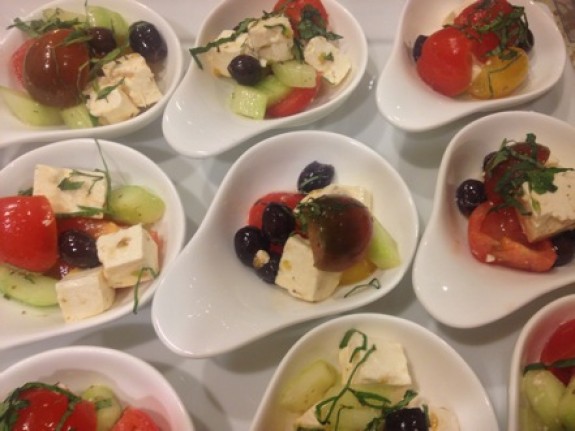
Greek Salad with Heirloom Tomatoes as interpreted by Four Seasons Hotel Executive Chef Douglas Anderson
Greek Salad with Heirloom Tomatoes
From Diet Simple Farm to Table Recipes: 50 New Reasons to Cook in Season!
8 servings
Ingredients:
Vinaigrette:
2 Tablespoons Freshly Harvested Extra Virgin Olive Oil
2 Tablespoons Freshly Squeezed Lemon Juice (1 Lemon)
1 Tablespoon Chopped Fresh Oregano or Basil (or 1 tsp dried)
1 Clove Garlic, Minced (optional)
Salt and Pepper to Taste (Salt is not necessary with the cheese and olives)
Vegetables:
2 cucumbers, peeled, seeded and sliced into a half-moon shape
1 onion, peeled and chopped coarsely
1 medium yellow, purple or green bell pepper, cored, seeded, chopped into large bite-size pieces
1 cup pitted Kalamata or other Greek Olives
4 Heirloom Tomatoes, quartered, and cut into large, bite-size pieces
4 ounces Feta or Goat Cheese, broken into small bits
Instructions:
Combine the vinaigrette ingredients in a large salad bowl and whisk until blended. Add the cucumbers, onion, pepper, and olives and toss into vinaigrette. Let sit for twenty minutes to marinate. Add the heirloom tomatoes and cheese when ready to serve.
Tomatoes are one of the “superfoods.” Men who consumed 10 or more servings of tomato products a week had a 35% decrease in risk of prostate cancer relative to those who consumed 1.5 servings or fewer per week. This is largely attributed to “lycopene” in the tomatoes, which is also in other red fruits such as watermelon, pink grapefruit and guava. Men with lycopene levels in the top 20% had a 46% decrease in risk of heart attack compared to those in the bottom 20%. Lycopene is a potent scavenger of gene-damaging free radicals. But don’t expect to get it from a supplement. You must eat the tomato as you need the whole food to receive the benefits! Here’s an explanation…
Lycopene (Red fruits such as tomatoes, watermelon, guava): Many studies have shown that lycopene-rich foods reduce the risk of prostate cancer, but the mechanism behind that reduction was not well understood until now. A recent study found that lycopene has a substantial protective effect against prostate cancer by interfering with the genes that would allow the prostate cancer cells to grow and survive. The American Institute for Cancer Research recommends that men take advantage of lycopene’s cancer-preventing effects and fill their diets with foods such as tomatoes, watermelon and guava.
- Bottom line: Fill your diet with lycopene-rich foods such as tomatoes, watermelon, and red grapefruit. Remember—the cancer-fighting properties of lycopene in tomatoes are much stronger when the tomatoes are cooked, such as in marinara sauce or tomato soup.
Summer Peach Crisp with Nuts, Dried Fruit and Ginger
- At August 20, 2013
- By Katherine
- In Recipes
 0
0
Today is the 11th “Katherine’s Market Recipe,” all of which are designed to be delicious, easy, quick, family-friendly, nutritious (heart-healthy & diabetes-friendly), and to highlight produce found at our local Farmers Markets this week. At your Farmers Market, you’ll find produce picked at peak ripeness, which means maximum flavor, texture and nutrition. You’re also helping save the environment when you buy at your Farmers Market. Here’s how…
For my “Autumn Apple Crisp with Nuts, Dried Fruits, and Ginger,” I recommend you buy the apples or pears at Georgetown’s Rose Park Farmers Market (your last chance this year) on Wednesday, or Dupont Circle’s Fresh Farm Market (open year-round) on Sunday.
Katherine’s Summer Peach Crisp with Nuts, Dried Fruit & Ginger
By Katherine Tallmadge, M.A., R.D.
This will become a favorite holiday dessert – delicious, but quick and simple, too. And, heart healthy – using predominantly whole grains and nut oil instead of butter – and filled with fruit and nuts.* This Apple Crisp is very versatile with its main ingredients. Use a crunchy, tart Fall Apple, an Anjou Pear, or a combination of both. Use any dried fruit, your favorite nut, and a nut oil for maximum flavor.
Serves 12
Filling:
½ Cup Pure Maple Syrup
½ Cup Raisins, Dried Cranberries, or a mix of both
2 Tablespoons Fresh Squeezed Lemon Juice
1 Tablespoon Minced Candied or Crystalized Ginger, or less if you like it less strong
2 Tablespoons All-Purpose Flour
3 pounds Seasonal, Ripe Peaches, peeled and thinly sliced
Topping:
1-1/2 Cups Old Fashioned Rolled Oats
½ Cup Chopped Walnuts, Pecans, Hazelnuts, any favorite Nut – or a mixture**
½ Cup Brown Sugar
1/3 Cup Whole Wheat Flour*
½ teaspoon Ground Cinnamon
1/3 Cup Walnut Oil, any Nut Oil,** or Canola Oil
Preheat oven to 350 degrees F.
Prepare filling: In a large bowl, mix the maple syrup, dried fruit, lemon juice, ginger, and flour. Add the peaches and mix well. Pour into a 9-by-13-inch baking dish.
Prepare Topping: Mix the oats, nuts, brown sugar, whole wheat flour, and cinnamon. Add the oil and mix until the topping is moist. Pour over the filling in the baking dish.
Bake for 45 to 50 minutes or until the apples are tender and the crumble is golden brown. Let stand for 10 minutes until serving
300 calories per serving.
“Katherine’s Summer Peach Crisp with Nuts, Dried Fruits, and Ginger” is adapted from a recipe in “Eating Well” Magazine.
*A whole grain – whole oats and whole wheat flour – has three parts: bran, germ and endosperm. The bran and germ contain fiber, Vitamin E, B vitamins (thiamin, niacin, riboflavin and pantothenic acid) minerals (calcium, magnesium, potassium, phosphorous, sodium, selenium and iron), protein, essential oils, antioxidants and phytochemicals (plant substances that may protect health). The endosperm contains mostly starch with a little protein and very few nutrients. When a grain is refined, turning whole wheat flour into white flour or brown rice into white rice, only the nutrient-poor endosperm is left. The heart-healthy, cancer-fighting riches found in the bran and germ are lost. Learn more about whole grains…
**Nuts – Every time a new study comes out about nuts – any nut – it’s positive news. Nut eaters around the world have fewer heart attacks, and we know that most of the protective nutrients are in the oil of the nut. While you already know each nut has a different look and flavor, each nut also has its own unique nutritional characteristics. For instance, almonds are the highest in protein and Vitamin E, and the lowest in artery-clogging saturated fat. Walnuts are the only nut with omega-3-fatty acids. Pecans have the highest antioxidant content. Pistachios contain lutein, a compound which may significantly improve eye health. ALL nuts are good for you. My favorite: Italian Hazelnuts!
Simple, Sumptuous, Seasonal Summer Recipes
- At August 20, 2013
- By Katherine
- In News, Recipes
 0
0
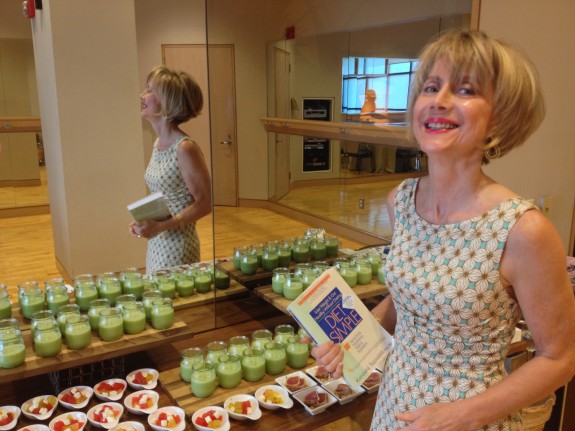
Katherine presenting: "Nutrition for Heart & Brain Health" at the Four Seasons Spa featuring recipes from "Diet Simple Farm to Table Recipes," uniquely prepared by Four Seasons' Hotel Executive Chef, Douglas Anderson, like Melon Chunks with Crumbled Feta and Fresh Mint, Cool Cucumber Soup, Seared Ahi Tuna with Wasabi Vinaigrette (photo by Viggy Parr)
Summer is a season filled with beauty!
Beautiful, sunny weather, beautiful afternoons spent with family and friends, and, of course, beautiful fresh produce straight from the garden. Summer is bursting with an abundance of delicious ingredients like juicy peaches, sweet melons, cool cucumbers and heirloom tomatoes. Take advantage of summer’s bounty with these quick and easy recipes… These recipes – and so many more – are found in my new Diet Simple companion cookbook:
Diet Simple Farm to Table Recipes: 50 New Reasons to Cook in Season!
ONLY $4.95! NEW PRICE!
Available soon as an e-book and paperback: $14.99
Melon Chunks with Crumbled Feta and Fresh Mint
Fresh Summer Salsa with Watermelon
Silvestro’s “Italian” Gazpacho
Kjerstin’s Chicken Salad with Sweet Melon, Peaches, and Toasted Walnuts
Salad of Fingerling Potatoes, Green and Yellow Beans with a Lemony-Garlic-Herb Dressing
Zucchini Ribbons with Fresh Lemon Vinaigrette
Fresh Kale and Summer Peach Salad with Toasted Almonds and Balsamic Vinaigrette
Summer Peach Crisp with Nuts, Dried Fruit and Ginger
Dark Chocolate Dipped Seasonal Fruit & Fruit Popsicles
These recipes and so many more can be found in Diet Simple Farm to Table Recipes: 50 Reasons to Cook in Season!
ONLY $4.95 (Available soon as an e-book and paperback for $14.95)

